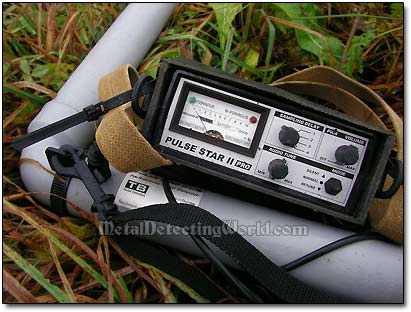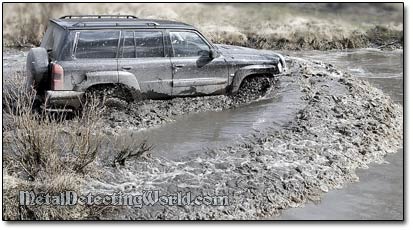Types of Metal Detecting Activities, page 12
COIN CACHE HUNTING: Types of Metal Detectors and Equipment Required
Types of Metal Detectors for Coin Hoard Hunting:
- Manually- or Self-adjustable metal detectors that are capable of detecting ALL types of coins, including the tiniest silver hammered coins, and using a large search coils (15" in diameter and larger) are essential for Cache Hunting Type I.
- Metal detectors with Auto Tune or S.A.T. (Self Adjusting Threshold) option are preferred.
Automatic tuning offers a significant advantage when searching over mineralized ground and helps keep the metal detector operating at maximum sensitivity without requiring constant adjustments by the operator. It improves the stability, reduces noise, and allows higher Gain settings to be used. - Multi-Frequency metal detectors, such as Minelab Explorer II Pro, Minelab Explorer SE, and Minelab E-Trac are the most effective for all types of cache hunting. These machines can effectively process the signal coming from a coin cache through the mineralized soil from great depths.
- Hand-Held Scanners are used for Type IV cache hunting.
- Two-Box detectors and Deep Seekers, such as Pulse Star II Pro - Pulse Induction metal detector, designed for locating deep sizable targets such as large hidden caches are essential for cache hunting of Types II and III.

Pulse Induction (PI) detectors of the conventional physical design can be used for cache hunting in rural areas where iron trash is not present in large quantities. PI detectors are intended for maximum depth under extreme search conditions such as highly mineralized ground. The shortcoming of PI detectors is their inability to identify and reject ferrous (iron) trash.
Necessary Detector's Features, Equipment and Accessories:
- Manual Ground Balance or Automatic Ground Balance (with all Multi-Frequency detectors and some VLF and High-Frequency detectors) feature should be incorporated into your metal detector circuitry.
- Auto Tune or S.A.T. (Self Adjusting Threshold) feature should be incorporated into your metal detector circuitry.
- All Metal mode for detecting the deeply buried large targets in areas that are free of shallow junk
- Headphones are required for being able to hear deep, "tiny" signals emitted by coin caches, and not to attract attention of passersbys nor annoy them with multiple "beeps" coming out of your metal detector's speaker.
- Round DD (Double D) Large Search Coils of 15 inches in diameter and larger should be used after the area has been cleared of shallow targets with a standard search coil.
- Hip-mount configuration for searching with large coils for extended amount of time.
- Small Search Coils of 6 inches and less in diameter - "snipers", can be used for Type IV cache hunting.
- Black Light Illuminators are used for searching for valuables stashed inside cellar walls (Type IV cache hunting).
- Treasure Hunting Shovel made of special steel (Lesche, Fiskars), with T-handle, and designed for digging targets in soils of any type.
- 3-Piece Steel Probe with a T-handle especially designed for locating large objects buried down to 1.8m. Just like with a coin probe, the searcher drives the probe vertically down through the soft or sandy soil until the probe hits something hard. An experienced searcher can identify the object's material (iron, aluminum, stone, wood, etc.) by feeling the vibrations received by the handle. This probe is also very useful as an accessory to 2-Box and Deep Seeking metal detectors.
- Thick Large Plastic Bags for transporting large amounts of soil mixed with coins
- Sturdy Light Gloves will protect your hands from accidental cutting by broken glass or sharp fragments of rusty sheet iron.
- Headlamp is good to have when your daylight coin shooting activity is likely to continue into the night hours. Headlamp is the must if you plan to do night hunts or search inside the confined spaces (Type IV cache hunting).
- Kneepads are recommended.
- A reliable 4x4 vehicle is sometimes the "must" to get to the remote and less accessible areas during coin cache hunting of the second and third types.

Make a Donation
Please help me stay afloat, afford more metal detecting trips with field-tests and experiments to create more informative articles, useful tutorials and helpful guides for detectorists, and maintain this website - the most informative hobby resource on the web! Since I do not have any steady income, any donation matters to me a lot! Thank you kindly!
Clicking on the donate button will take you to a donation page powered by Donorbox and dedicated to my website (MetalDetectingWorld.com). The donation page is PCI-compliant, secured by SSL/TLS, and has a simple form to fill out. Donorbox does not store any card or bank data. Credit card information is encrypted and tokenized by the Stripe payment processor.
This website would not exist without the advertisements we display and your kind donations. If you are unable to support us by viewing our advertisements, please consider making a Donation to ensure the future of this website. By helping me keep this website alive and growing, you will sure help many detectorists around the world as well!
ANNOUNCEMENT:
In January of 2020, I started a one-time fund-raising campaign in attempt to accumulate enough money to buy a simple but reliable 4x4 vehicle. My old 4x4 car (made in 1995) had faithfully served me for 10 years before it eventually went beyond repair last October. Without a 4WD, I will not be able to get to my hunt sites and test-plots hidden in the remote wooded areas inaccessible by a regular car.
Unlucky for me, those sites are the only locations available and suitable for my field-work which results in informative articles you can find on this website. For the past 10 years, my usual field-work has consisted of field-testing the latest metal detectors and accessories, experimenting with some of them, and devising new effective search methods that meet the requirements of the new metal detecting reality.
Before my car died, I managed to finish a couple of interesting detector-testing projects which will be covered in my upcoming articles. But other equally important projects that I was working on were not completed and had to be postponed until the Spring 2020. I hope that this fund-raising campaign will help me get a decent 4x4 by then so that I will be able to resume my work and to write more new articles, tutorials and guides based on data gathered through testing and experimentation.
If you find my website useful and would like it to provide more essential info for you and other detectorists worldwide, please consider chipping in $5, $20, $50 or whatever you can afford to keep MetalDetectingWorld.com growing in 2020. I promise you, it will be money well spent. Thank you.
Donate- Please help me promote this guide:
If you would like to follow me on Twitter, please press a button:
I have my profile page on
where you can share your thoughts on this article, ask me a question, or place a friend request.I also have my profile pages on Pinterest, LinkedIn, Tumblr, Reddit and Delicious
and my "Metal Detecting World" page on Twitter, Pinterest and Tumblr
I no longer maintain my old Facebook page